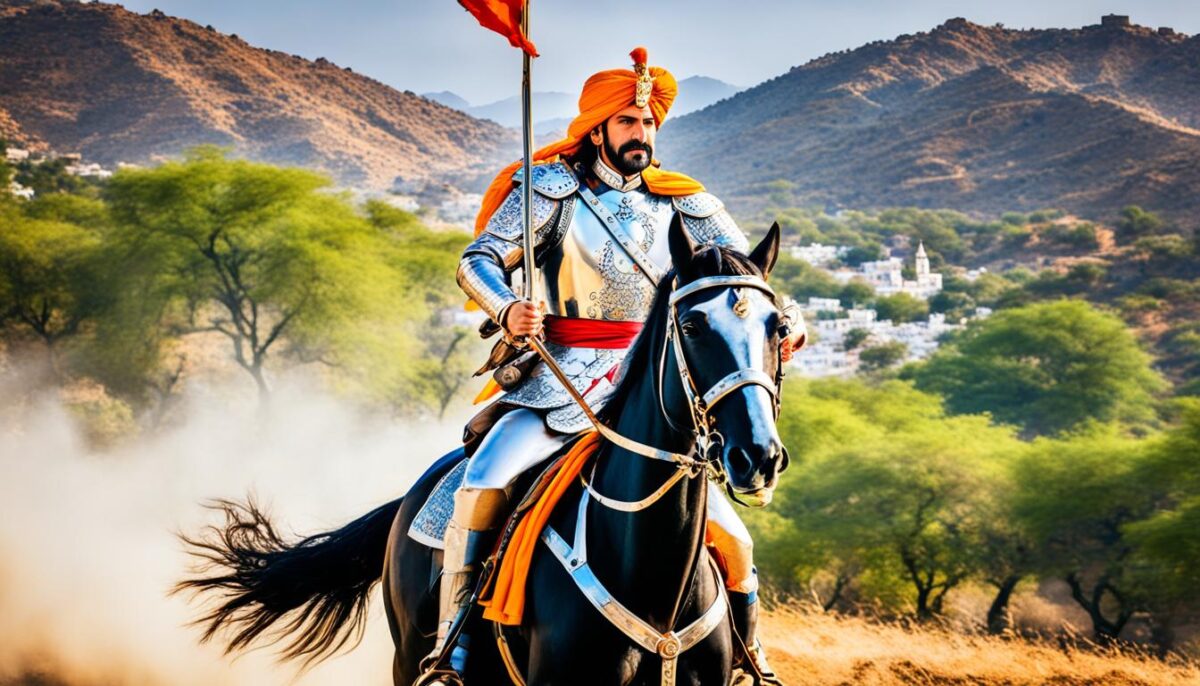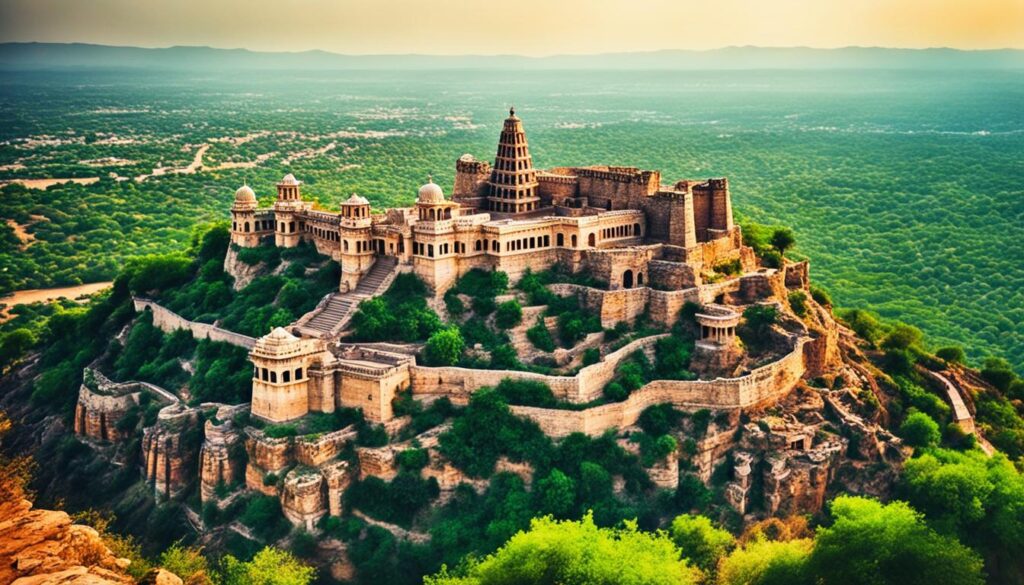Imagine a Rajput warrior with two massive 25-kilogram swords. He stood against the Mughal Empire alone. This warrior, Maharana Pratap, showed the power of unwavering patriotism. He inspired Rajputs to fight for their land and rights.
Maharana Pratap is a key figure in Indian history. He’s seen as a symbol of bravery for leading a fight against the Mughal Empire. Not only did he show great courage and valor, but his loyalty to India also shines. He won the famous Battle of Haldighati against Emperor Akbar’s bigger army. His fight symbolizes what it means to love and be loyal to one’s country.
Key Takeaways
- Maharana Pratap was an iconic Rajput warrior who defied the Mughal Empire to preserve the sovereignty of Rajputana.
- He is celebrated for his courage, valor, and unwavering loyalty to his motherland, becoming a symbol of bravery and patriotism.
- The Battle of Haldighati was one of Maharana Pratap’s greatest victories, where he defeated a larger Mughal army led by Emperor Akbar’s forces.
- Maharana Pratap’s legacy continues to inspire Indians, serving as an example of what it means to be dedicated and loyal to one’s country.
- Maharana Pratap is remembered as a symbol of Rajput pride and the fight for freedom against foreign domination.
Introduction to Maharana Pratap
Maharana Pratap is a key figure in India’s history. He’s known as a fearless Rajput warrior. He stood against the Mughal Empire to protect the independence and values of Rajputana. Apart from his bravery, he’s admired for his love for his home. He’s symbolized as a hero of courage and love for the nation.
Iconic Figure in Indian History
Maharana Pratap showed what true love for India is. His unwavering commitment serves as a lesson on patriotism and loyalty. He is and will always be a source of inspiration for all Indians.
Brave Rajput Leader Against Mughal Empire
He did not bow to the Mughal Empire‘s rule and fought to keep Mewar kingdom free. His acts of courage and wise leadership in tough times have made him a beloved historial figure.
Battle of Haldighati – Greatest Battle
The battle of Haldighati was one of his significant victories. He won against a large Mughal force led by Emperor Akbar. This win highlights Maharana Pratap’s fearlessness to protect his land.
Maharana Pratap’s Early Life and Upbringing
Maharana Pratap was not just any Rajput warrior. He was a key figure in the Mewar kingdom‘s history. In 1572, he was born into a powerful Rajput Hindu family. This family belonged to the esteemed Sisodia dynasty.
As a child, Pratap was taught everything a Rajput leader needed to know. He learned about warfare, hunting, and how to ride a horse. This was all part of his training as a future king. These early lessons deeply influenced Pratap. They taught him the values of bravery, faithfulness, and love for his land.
Born into Rajput Sisodia Dynasty
Pratap was proud to be part of the Sisodia clan. This clan was at the heart of the Mewar kingdom‘s royal history. His father, Maharana Udai Singh II, started the city of Udaipur. This made Pratap’s family very special. They had a long history of leading their people.
Groomed for Kingship from Young Age
At a young age, Pratap began learning the skills of a leader. He was taught many things about fighting and leading an army. This included how to plan strategies and use weapons. It would all be very important in his future battles against the powerful Mughal Empire.
Training in Warfare and Rajput Traditions
Pratap’s education wasn’t just about fighting. He also learned a lot about the Rajput traditions and the culture of his people. He understood how important honor and loyalty were. These lessons influenced his later actions. They drove him to stand strong against Mughal rule to protect Mewar.
maharanapratap history: Resistance Against Mughal Expansion
Maharana Pratap never gave in to Mughal rule. He refused Emperor Akbar’s demands. Instead, he fought back. Akbar tried to break his spirit with war, but Maharana Pratap fought valiantly until the end.
Refusal to Submit to Akbar’s Rule
Maharana Pratap was committed to his kingdom’s independence. He refused Mughal Empire’s attempts to overtake Mewar. He stood firm, upholding Rajput values of honor and freedom.
Battles Against Mughal Forces
He fought many battles against the Mughals. Using guerrilla tactics, he made the most of Mewar’s tough landscapes. This conflict showed the complicated politics and the fight for power against Mughal expansion.
Guerilla Warfare Tactics
Using the land’s features and forming alliances with other leaders was key to Pratap’s fight. These tactics, also used by Shivaji later on, showed the resilience of the Rajput people.
Maharana Pratap’s fight against the Mughals is an important part of India’s independence story. It is an inspiration. It shows the power and resilience of the Rajputs against foreign rule.
Battles and Conflicts
Maharana Pratap is famous for his skills in war. He fought many battles of maharana pratap against the Mughal Empire. One well-known battle was the Battle of Haldighati in 1576. Here, Maharana Pratap faced a large Mughal force under Raja Man Singh of Amber. Despite showing great rajput bravery, Maharana Pratap’s army had to withdraw since they were outnumbered.
Earlier, Maharana Pratap had a long siege of chittorgarh, Mewar’s capital, against Mughal rule. Then, in the Battle of Dewair in 1582, his troops defeated Mughals under Man Singh I. This victory increased the confidence of the Rajput fighters. These battles highlighted Maharana Pratap’s smart military leadership and his commitment to protect his home from outsiders.
Legacy and Cultural Impact
Maharana Pratap is a key figure in Indian history. He is a symbol of courage, love for his land, and the struggle against outsiders. His story inspired many during the fight for freedom from colonial rule. His bravery and stand against the Mughals are still honored today.
His influence doesn’t stop there. It has deeply affected Indian art, literature, and pop culture. His character appears in various forms of entertainment. His brave deeds and strong will attract and uplift young Indians, ensuring his memory lasts for generations.
Symbol of Bravery and Patriotism
Maharana Pratap stood firm for the freedom and honor of his land, Mewar. His refusal to bow to the Mughals has made him legendary. He is a true symbol of rajput bravery and the fight for liberty.
Inspiration for Indian Independence Movement
Pratap’s fight against all odds inspired many. His example boosted those who aimed to free India from British rule. He symbolizes the Indian independence movement, showing the strength of Rajputs against outsiders.
Influence on Art, Literature, and Pop Culture
His impact on Indian art and literature is immense. The depiction of his character in various media shows his ongoing influence. His bravery and strong spirit continue to inspire Indians. His legacy remains powerful, ensuring his story is passed on for many more years.
Relationship with Other Rajput Rulers
Maharana Pratap had a complex relationship with other rajput rulers. Some joined the mughal-rajput relations. But others, like him, resisted.
The alliance between the Rajputs and Mughals was powerful in Pratap’s time. After Pratap, they both sought control in India, sometimes through peace and sometimes war. They disagreed but also showed religious tolerance and shared their cultures, which influenced India’s history.
| Key Mughal-Rajput Conflicts | Timeline | Notable Battles |
|---|---|---|
| Mughal-Rajput Wars | 1526 to 1779 | Battle of Khanwa (1527), Battle of Haldighati (1576), Battle of Jodhpur (1707), Battle of Gangwana (1741) |
| Rajput Rebellion | 1679 to 1707 | Siege of Kanud, Battle of Khatu Shyamji (1779) |
| Mughal Subjugation of Mewar | 1616 | – |
Maharana Pratap greatly depended on his maharana pratap allies in fighting the Mughals. While some Rajput rulers sided with the Mughals, Pratap’s allies remained loyal. This support from his allies was key in protecting Mewar’s independence. The relationships and struggles among the Rajputs continued to influence India’s future long after Pratap.
Maharana Pratap’s Family and Lineage
Maharana Pratap was born into the famous Sisodia clan. He was the son of Maharana Udai Singh II and Maharani Jaiwanta Bai. Pratap married Maharani Ajabde Punwar and Maharani Solanki Bai. Both wives supported and inspired him during his rule. His children, like Amar Singh and Kunwar Shakti Singh, carried on his mission after he died.
| Spouse | Title |
|---|---|
| Maharani Ajabde Punwar | Also known as Phool Kanwar |
| Maharani Solanki Bai | Also known as Rani Dheer Bai or Rani Bai Sa |
| Jaso Bai Chauhan | – |
| Other Spouses | Maharana Pratap had a total of 11 spouses |
Maharana Pratap had 22 sons, among them were Amar Singh I and Bhagwan Das. He also had 5 daughters. Pratap was the 54th ruler of Mewar. He ruled for 35 years from 1572 to 1597.
Significance of Chittorgarh Fort
Chittorgarh Fort marks an important chapter in Indian history. It symbolizes Maharana Pratap’s stand against the Mughal invasion. As the capital of Mewar, it embodied the Rajputs’ unyielding courage.
Pratap fought a long battle to retake Chittorgarh from the Mughals, aiming to restore his homeland’s freedom.
Capital of Mewar
Though he never managed to take Chittorgarh back, the fort stayed a vital symbol. It inspired Mewar’s resistance against Mughal rule. For Pratap and his allies, it served as a reminder of their aim: freedom from foreign control.
Symbol of Resistance and Defiance
The stories of Chittorgarh’s defenders’ valor still amaze and encourage Indians today. This fort is more than stone walls; it stands for the Rajput’s unbreakable spirit. It shows how people can resist even the toughest challenges.
Historical Significance
Chittor Fort spans 700 acres and dates back to the 7th century CE. It was built by the Mauryans. The site is also linked to many important figures from Jain tradition.
Chittorgarh’s location and its strong defenses have always been key to the Mewar kingdom’s safety and power.
| Key Facts about Chittorgarh Fort | Details |
|---|---|
| Size | 700 acres (280 hectares) on a seven-mile-long hill |
| Founder | Bappa Rawal, the legendary founder of the Sisodia dynasty, received Chittor in the 8th century |
| Sieges and Sackings | Chittor was surrounded, overrun, and sacked three times between the 8th and 16th centuries |
| Defenders’ Sacrifice | In 1303, during the siege of Chittor, 7,000 Rajput warriors died, indicating the significant loss of life during battles |
| Military Defense | Rana Kumbha built a chain of thirty forts around the kingdom, highlighting the strategic military approach to defense |
| Rajput Valor | Rana Sanga fought numerous battles and received eighty-four wounds on his body, showcasing his valor and resilience |
| Destruction | In 1567, Chittorgarh was razed to the ground by Emperor Akbar, displaying the destruction faced by the kingdom |
| Maharana Pratap’s Persistence | Maharana Pratap engaged in guerilla warfare for twenty years after the battle at Haldighati in 1576, underscoring his perseverance |
Chittorgarh Fort is more than just a monument. It played a key role in the fight against the Mughals. Its status as a symbol of freedom and bravery still moves and inspires today.
Conclusion
Maharana Pratap was a fearless Rajput warrior. He symbolized resisting foreign rule. Even after many centuries, he continues to inspire Indians.
His fight was for the freedom of Mewar. He stood strong against Mughal forces. Pratap is a major figure in Indian history.
He inspires the Indian independence movement. People saw his courage against great odds as a guide in their fight for freedom. Pratap’s legacy will always be celebrated in India.
FAQ
Who was Maharana Pratap?
Maharana Pratap was a fearless Rajput leader in Indian history. He fought against the Mughal Empire. His goal was to protect the land and the beliefs of Rajputana. People remember him for his bravery, valor, and love for his country.
What was the significance of the Battle of Haldighati?
The Battle of Haldighati was a significant fight for Maharana Pratap. He faced a large army from the Mughal Empire, led by Emperor Akbar. Despite being outnumbered, Pratap showed great military strategy and a strong will to protect his home against outside rule.
How did Maharana Pratap’s legacy inspire the Indian independence movement?
Maharana Pratap’s love for India and his stand against the Mughal rule inspired freedom fighters. His refusal to bow down to outsiders made him an example of courage and love for the homeland. For many, his story fueled the fight against colonialism, making him a hero of bravery and patriotism.
What was Maharana Pratap’s relationship with other Rajput rulers during his time?
Maharana Pratap’s bond with other Rajputs varied. Some chose to side with the Mughals, while others fought with him against foreign rule. This led to a mix of peace and conflict between the Maharana and the Mughal Empire, as each tried to gain political power.
What was the significance of Chittorgarh Fort in Maharana Pratap’s resistance against the Mughals?
Chittorgarh Fort was key in Maharana Pratap’s fight against the Mughals. He waged a tough battle to take back control from the Mughal Empire. The fort’s tales of bravery by its guardians still move and intrigue Indians today.



